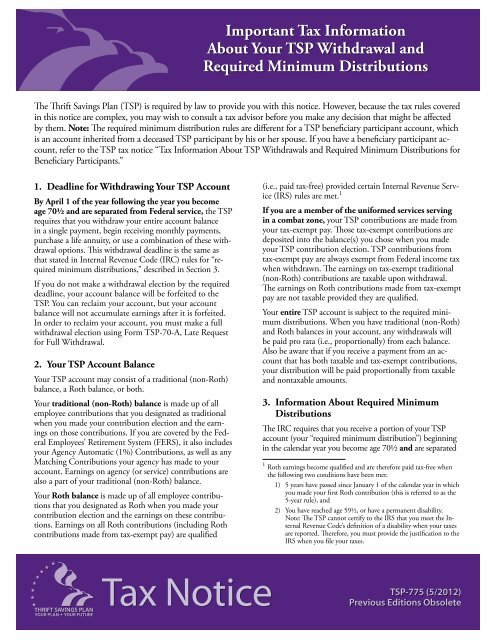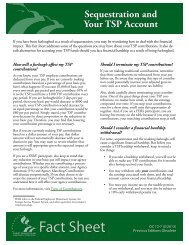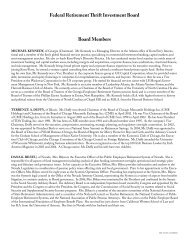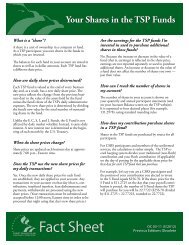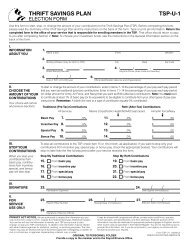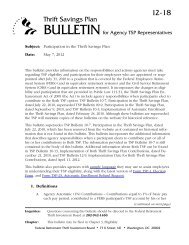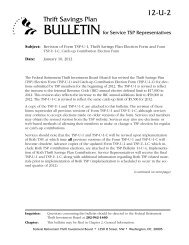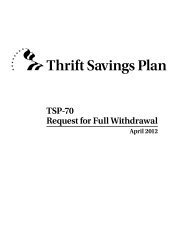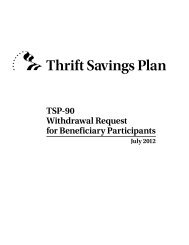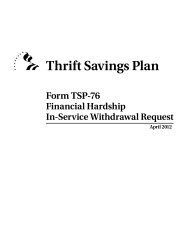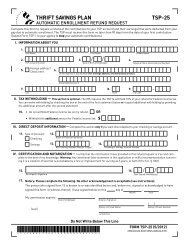Tax Notice: Important Tax Information About Your TSP Withdrawal ...
Tax Notice: Important Tax Information About Your TSP Withdrawal ...
Tax Notice: Important Tax Information About Your TSP Withdrawal ...
You also want an ePaper? Increase the reach of your titles
YUMPU automatically turns print PDFs into web optimized ePapers that Google loves.
1. Deadline for Withdrawing <strong>Your</strong> <strong>TSP</strong> Account<br />
By April 1 of the year following the year you become<br />
age 70½ and are separated from Federal service, the <strong>TSP</strong><br />
requires that you withdraw your entire account balance<br />
in a single payment, begin receiving monthly payments,<br />
purchase a life annuity, or use a combination of these withdrawal<br />
options. This withdrawal deadline is the same as<br />
that stated in Internal Revenue Code (IRC) rules for “required<br />
minimum distributions,” described in Section 3.<br />
If you do not make a withdrawal election by the required<br />
deadline, your account balance will be forfeited to the<br />
<strong>TSP</strong>. You can reclaim your account, but your account<br />
balance will not accumulate earnings after it is forfeited.<br />
In order to reclaim your account, you must make a full<br />
withdrawal election using Form <strong>TSP</strong>-70-A, Late Request<br />
for Full <strong>Withdrawal</strong>.<br />
2. <strong>Your</strong> <strong>TSP</strong> Account Balance<br />
<strong>Your</strong> <strong>TSP</strong> account may consist of a traditional (non-Roth)<br />
balance, a Roth balance, or both.<br />
<strong>Your</strong> traditional (non-Roth) balance is made up of all<br />
employee contributions that you designated as traditional<br />
when you made your contribution election and the earnings<br />
on those contributions. If you are covered by the Federal<br />
Employees’ Retirement System (FERS), it also includes<br />
your Agency Automatic (1%) Contributions, as well as any<br />
Matching Contributions your agency has made to your<br />
account. Earnings on agency (or service) contributions are<br />
also a part of your traditional (non-Roth) balance.<br />
<strong>Your</strong> Roth balance is made up of all employee contributions<br />
that you designated as Roth when you made your<br />
contribution election and the earnings on these contributions.<br />
Earnings on all Roth contributions (including Roth<br />
contributions made from tax-exempt pay) are qualified<br />
THRIFT SAVINGS PLAN<br />
YOUR PLAN YOUR FUTURE <strong>Tax</strong><br />
<strong>Notice</strong> <strong>TSP</strong>-775<br />
<strong>Important</strong> <strong>Tax</strong> <strong>Information</strong><br />
<strong>About</strong> <strong>Your</strong> <strong>TSP</strong> <strong>Withdrawal</strong> and<br />
Required Minimum Distributions<br />
The Thrift Savings Plan (<strong>TSP</strong>) is required by law to provide you with this notice. However, because the tax rules covered<br />
in this notice are complex, you may wish to consult a tax advisor before you make any decision that might be affected<br />
by them. Note: The required minimum distribution rules are different for a <strong>TSP</strong> beneficiary participant account, which<br />
is an account inherited from a deceased <strong>TSP</strong> participant by his or her spouse. If you have a beneficiary participant account,<br />
refer to the <strong>TSP</strong> tax notice “<strong>Tax</strong> <strong>Information</strong> <strong>About</strong> <strong>TSP</strong> <strong>Withdrawal</strong>s and Required Minimum Distributions for<br />
Beneficiary Participants.”<br />
(i.e., paid tax-free) provided certain Internal Revenue Service<br />
(IRS) rules are met. 1<br />
If you are a member of the uniformed services serving<br />
in a combat zone, your <strong>TSP</strong> contributions are made from<br />
your tax-exempt pay. Those tax-exempt contributions are<br />
deposited into the balance(s) you chose when you made<br />
your <strong>TSP</strong> contribution election. <strong>TSP</strong> contributions from<br />
tax-exempt pay are always exempt from Federal income tax<br />
when withdrawn. The earnings on tax-exempt traditional<br />
(non-Roth) contributions are taxable upon withdrawal.<br />
The earnings on Roth contributions made from tax-exempt<br />
pay are not taxable provided they are qualified.<br />
<strong>Your</strong> entire <strong>TSP</strong> account is subject to the required minimum<br />
distributions. When you have traditional (non-Roth)<br />
and Roth balances in your account, any withdrawals will<br />
be paid pro rata (i.e., proportionally) from each balance.<br />
Also be aware that if you receive a payment from an account<br />
that has both taxable and tax-exempt contributions,<br />
your distribution will be paid proportionally from taxable<br />
and nontaxable amounts.<br />
3. <strong>Information</strong> <strong>About</strong> Required Minimum<br />
Distributions<br />
The IRC requires that you receive a portion of your <strong>TSP</strong><br />
account (your “required minimum distribution”) beginning<br />
in the calendar year you become age 70½ and are separated<br />
1 Roth earnings become qualified and are therefore paid tax-free when<br />
the following two conditions have been met:<br />
1) 5 years have passed since January 1 of the calendar year in which<br />
you made your first Roth contribution (this is referred to as the<br />
5-year rule), and<br />
2) You have reached age 59½, or have a permanent disability.<br />
Note: The <strong>TSP</strong> cannot certify to the IRS that you meet the Internal<br />
Revenue Code’s definition of a disability when your taxes<br />
are reported. Therefore, you must provide the justification to the<br />
IRS when you file your taxes.<br />
(5/2012)<br />
Previous Editions Obsolete
from Federal service. That year is called your first distribution<br />
calendar year. If you do not make a withdrawal election<br />
and begin receiving payments from your account before or<br />
during your first distribution calendar year, the <strong>TSP</strong> is required<br />
to make the required distribution to you by April 1<br />
of the following year. That date is called your required withdrawal<br />
date, and that date occurs in your second distribution<br />
calendar year. For administrative purposes, the <strong>TSP</strong> will<br />
issue this required minimum distribution on March 1 or the<br />
last business day before March 1 of your second distribution<br />
calendar year. If you do not then make a withdrawal election<br />
for your entire account balance by April 1 of your second<br />
distribution calendar year, your account will be forfeited to<br />
the <strong>TSP</strong> as described in Section 1.<br />
If you make a partial withdrawal, withdraw your entire account<br />
in a single payment, begin withdrawing it through a<br />
series of monthly payments, or purchase an annuity, the <strong>TSP</strong><br />
will ensure that your withdrawal satisfies the IRC minimum<br />
distribution requirement. However, if your <strong>TSP</strong> account<br />
record has an incorrect birth or separation date, or if your<br />
agency or service is late in reporting the date of your separation,<br />
you may not receive a payment that satisfies the minimum<br />
distribution requirement by the applicable deadline.<br />
If this occurs, you may be subject to an IRS penalty tax of<br />
50% on the amount that was not paid to you on time. To<br />
avoid this penalty, you must be sure that the information in<br />
your <strong>TSP</strong> record is correct and that your agency or service<br />
reports your separation promptly.<br />
4. How <strong>Your</strong> <strong>Withdrawal</strong> Payment Satisfies the<br />
Required Minimum Distribution<br />
The <strong>TSP</strong> calculates the annual amount of your required<br />
minimum distribution based on your prior year-end account<br />
balance and your age using the Uniform Lifetime Table,<br />
Treas. Reg. § 1.401(a)(9)-9, Q&A-2, as published in the<br />
Federal Register on April 17, 2002. 2 (See the last page of this<br />
notice.) Because the same table is used to calculate monthly<br />
payments based on life expectancy for a participant who is<br />
70 or older, if you withdraw your entire account using that<br />
option, you will automatically satisfy the minimum distribution<br />
requirement.<br />
Required minimum distributions cannot be transferred to<br />
an IRA or eligible employer plan. Therefore, if you are required<br />
to receive a minimum distribution and you choose to<br />
transfer your single payment or an eligible monthly payment<br />
when you make your withdrawal election, the <strong>TSP</strong> will calculate<br />
your required minimum distribution amount, remove<br />
it from the transfer, and mail it directly to you in a separate<br />
check, or send it to your checking or savings account if you<br />
2 If you have both a civilian <strong>TSP</strong> account and a uniformed services <strong>TSP</strong> account,<br />
the minimum distribution is calculated separately for each account.<br />
chose direct deposit. The discussion in this section describes<br />
how a minimum distribution payment is made when there<br />
is no transfer involved.<br />
What Happens During <strong>Your</strong> First Distribution<br />
Calendar Year<br />
If you make your withdrawal in the year you become age<br />
70½ and are separated (i.e., in your first distribution calendar<br />
year), the following will happen:<br />
• If you take your entire account as a single payment,<br />
your required minimum distribution is included in<br />
that payment;<br />
• If you take your entire account as a series of monthly<br />
payments (other than payments based on life expectancy),<br />
your monthly payments will count toward<br />
satisfying your required minimum distribution. If<br />
necessary, the <strong>TSP</strong> will give you a supplemental payment<br />
by March 1 of the following year to satisfy your<br />
minimum distribution requirement;<br />
• If you take your entire account in the form of an<br />
annuity, the annuity payment will satisfy your minimum<br />
distribution requirement.<br />
If you make a mixed withdrawal, your required minimum<br />
distribution will be sent to you as follows:<br />
• If you select an annuity and a single payment, in a<br />
separate check before your withdrawal is processed<br />
(i.e., before your annuity is purchased and before your<br />
single payment is distributed).<br />
• If you select an annuity and monthly payments, in<br />
a separate check before your annuity is purchased and<br />
before your monthly payments begin.<br />
• If you select single and monthly payments, in the<br />
same check as your single payment. If your single payment<br />
does not satisfy your entire required minimum<br />
distribution, your monthly payments will be used to<br />
satisfy the amount remaining. If the requirement is<br />
still not expected to be satisfied by March 1 of your<br />
second minimum distribution calendar year, the <strong>TSP</strong><br />
will send you a supplemental payment for the remaining<br />
amount by March 1.<br />
• If you select an annuity and single and monthly<br />
payments, in a separate check before your annuity is<br />
purchased and before your single and monthly payments<br />
begin.<br />
If you make a partial withdrawal, your payment will be<br />
used to satisfy your required minimum distribution. However,<br />
if it does not satisfy your required distribution, the following<br />
will happen: If you withdraw the rest of your account during<br />
the same calendar year as your partial withdrawal, your<br />
2
withdrawal payment(s) will be used to satisfy your remaining<br />
required minimum distribution according to the type of<br />
withdrawal you elect; if you withdraw the rest of your account<br />
between January 1 and March 1 of the year following your<br />
first minimum distribution calendar year, the <strong>TSP</strong> will also<br />
use your withdrawal payment(s) to satisfy your remaining first<br />
year required minimum distribution. You will still be required<br />
to satisfy your required minimum distribution for your second<br />
minimum distribution calendar year. If you do not make a<br />
full withdrawal election by March 1 of the second distribution<br />
year, you will forfeit your account. (See Section 1.)<br />
What Happens During <strong>Your</strong> Second Distribution<br />
Calendar Year<br />
If you make your withdrawal after January 1, but before<br />
March 1 of your second distribution calendar year, the<br />
following will happen:<br />
• If you take your entire account as a single payment,<br />
your required minimum distribution for both your<br />
first and your second distribution calendar years will<br />
be included in your single payment check.<br />
• If you take your entire account balance in a series<br />
of monthly payments (other than payments based<br />
on life expectancy), each monthly payment will be<br />
used to satisfy your required minimum distribution<br />
until the total amount of that distribution has been<br />
satisfied for the year. If your first distribution year’s<br />
required minimum distribution is not satisfied before<br />
March 1 of your second distribution calendar year, a<br />
supplemental check will be mailed to you to satisfy the<br />
remaining required distribution amount. Beginning in<br />
March of your second distribution calendar year — or<br />
beginning with the first monthly payment after your<br />
first distribution year’s minimum distribution requirement<br />
has been satisfied (whichever is sooner) — your<br />
monthly payments will be used to satisfy your required<br />
distribution for your second distribution calendar year.<br />
If your second year’s required minimum distribution is<br />
not satisfied by December 31, the <strong>TSP</strong> will send you<br />
a supplemental payment to satisfy the remaining required<br />
minimum distribution amount.<br />
• If you take your entire account in the form of an annuity,<br />
the annuity purchase will satisfy your required<br />
minimum distributions for both your first and second<br />
distribution calendar years.<br />
If you make a mixed withdrawal, you will receive your<br />
required minimum distribution as follows:<br />
If your mixed withdrawal includes an annuity, your first distribution<br />
year’s required minimum distribution will be paid<br />
to you in a check before your mixed withdrawal has been<br />
processed. The rest of your withdrawal will be used to satisfy<br />
your second minimum distribution, as described below:<br />
• First, a portion of your annuity will be used to satisfy<br />
your second distribution calendar year’s required<br />
minimum distribution. That portion will represent the<br />
same percentage of your withdrawal that your annuity<br />
represents. In other words, if you choose to purchase<br />
an annuity with 50% of your account balance, then<br />
50% of your required minimum distribution amount<br />
will be satisfied through your annuity.<br />
• Then, if your mixed withdrawal contains a single payment,<br />
that payment will be used to satisfy the required<br />
distribution from the <strong>TSP</strong>.<br />
• If you choose monthly payments as part of your mixed<br />
withdrawal and your required minimum distribution<br />
has not been completely satisfied through your annuity<br />
and single payment, each monthly payment will be<br />
used to satisfy your required minimum distribution<br />
until the total amount has been satisfied. If your total<br />
required minimum distribution has not been satisfied<br />
before December 31, the <strong>TSP</strong> will send you a supplemental<br />
payment to satisfy the remaining amount.<br />
If your mixed withdrawal does not include an annuity, your<br />
single payment will be used to satisfy your required minimum<br />
distribution for your first distribution calendar year.<br />
If the single payment does not satisfy it, then your monthly<br />
payments will be used to satisfy the remaining amount. If the<br />
first year’s required amount is still not satisfied by March 1 of<br />
your second minimum distribution calendar year, a supplemental<br />
check will be mailed to you to satisfy the amount<br />
remaining. Beginning in March — or with your first monthly<br />
payment after your first distribution calendar year’s required<br />
minimum distribution has been satisfied (whichever is sooner)<br />
— your monthly payments will be used to satisfy your<br />
required minimum distribution for your second distribution<br />
calendar year. If that amount is not satisfied by December 31<br />
of that year, the <strong>TSP</strong> will send you a supplemental payment<br />
to satisfy the amount remaining.<br />
If you make a partial withdrawal, the partial payment will<br />
be used to satisfy your first distribution calendar year’s required<br />
minimum distribution first. If the amount of the partial<br />
payment is not enough to satisfy your first year’s minimum<br />
distribution, your full withdrawal election (which must also<br />
be completed by April 1) will be used to satisfy the remaining<br />
amount of your first year’s required minimum distribution.<br />
The payments made in accordance with your full withdrawal<br />
election (including monthly payments) will also be used to satisfy<br />
your second year’s required minimum distribution. If your<br />
full withdrawal is not completed by March 1, a supplemental<br />
check for the remaining amount of the first distribution calendar<br />
year’s required minimum distribution will be sent to<br />
you. If your full withdrawal election is still not completed by<br />
3
April 1, your remaining account balance will be forfeited to<br />
the <strong>TSP</strong> as explained in Section 1, “Deadline for Withdrawing<br />
<strong>Your</strong> <strong>TSP</strong> Account.”<br />
If your partial withdrawal is larger than your first distribution<br />
calendar year’s required minimum distribution, it will<br />
also be used to pay all or part of your second distribution<br />
calendar year’s required minimum distribution.<br />
5. <strong>Tax</strong> Withholding From <strong>Your</strong> <strong>Withdrawal</strong><br />
We must withhold Federal income tax from the taxable portion3<br />
of <strong>TSP</strong> payments made directly to you. For withholding<br />
purposes, there are three types of payments: eligible rollover<br />
distributions, periodic payments, and non-periodic payments.<br />
Federal income tax withholding rules are different for<br />
each type of payment as described in this section. The <strong>TSP</strong><br />
does not withhold amounts for state or local income tax.<br />
Eligible Rollover Distributions<br />
The following <strong>TSP</strong> payments are eligible rollover distributions:<br />
• A single payment of your entire <strong>TSP</strong> account after<br />
you separate from service.<br />
• A single payment of part of your <strong>TSP</strong> account after<br />
you separate from service (i.e., a partial withdrawal).<br />
• Monthly payments when the payment amount you<br />
choose is expected to be paid out in less than 10 years<br />
(except payments computed by the <strong>TSP</strong> according to<br />
the IRS life expectancy tables).<br />
• A final single payment made after a series of monthly<br />
payments.<br />
• Amounts paid directly to you after the complete withdrawal<br />
of your <strong>TSP</strong> account (e.g., late contributions).<br />
The following tax withholding rules apply to eligible rollover<br />
distributions:<br />
• The mandatory tax withholding on all eligible rollover<br />
distributions of $200 or more paid in a single year is<br />
20%. Withholding applies only to the taxable portion<br />
of your distribution. Therefore, if your distribution<br />
contains tax-exempt contributions, Roth contributions,<br />
or qualified Roth earnings, these amounts are<br />
not subject to withholding. Be aware that tax withholding<br />
is not the same as actual tax due. When you<br />
file your annual Federal income tax return, you may<br />
be entitled to a refund of a portion of this amount, or<br />
you may be required to pay an additional amount.<br />
3 The taxable portion of your payment includes any traditional (non-Roth)<br />
contributions that you made (other than those made from tax-exempt<br />
pay), any Agency Automatic or Matching contributions (if you are FERS),<br />
earnings on your traditional contributions and agency contributions, and<br />
any Roth earnings that are not qualified.<br />
• You can avoid withholding on all or any portion of<br />
an eligible rollover distribution by asking the <strong>TSP</strong> to<br />
transfer that amount to an IRA or eligible employer<br />
plan. If you transfer any portion of your traditional<br />
balance to a Roth IRA, you will have to pay Federal<br />
income tax on the taxable amount that you transfer.<br />
The tax is owed for the year the transfer is made. Roth<br />
IRAs are explained in more detail in Section 6.<br />
• You cannot avoid the mandatory 20% withholding<br />
on any taxable amounts that you elect to receive directly,<br />
including a payment made by direct deposit to<br />
your personal checking or savings account, even if you<br />
then roll it over to an IRA or eligible employer plan.<br />
(See Section 6.)<br />
• You may elect to have an amount withheld in addition<br />
to the 20% withholding by completing the tax<br />
withholding section of your withdrawal form.<br />
• There is no withholding on eligible rollover distributions<br />
that are less than $200. The $200 minimum<br />
amount applies to the total dollar amount of all eligible<br />
rollover distributions the <strong>TSP</strong> makes to you in a<br />
single tax year.<br />
• There will be no withholding on monthly payments<br />
until the total dollar amount of payments for the<br />
calendar year reaches $200. Once payments reach<br />
$200, the <strong>TSP</strong> will withhold taxes for the entire taxable<br />
amount you received during that tax year. Withholding<br />
for the remaining amount of that tax year<br />
will be calculated based on the dollar amount of each<br />
monthly payment. (For example, if you are withdrawing<br />
your account in monthly payments and are<br />
receiving $100 per month when they begin, there will<br />
be no withholding from your first monthly payment;<br />
however, when you receive your second monthly payment,<br />
withholding will be calculated based on $200.<br />
Withholding on subsequent monthly payments will<br />
be calculated based on $100 — the actual amount of<br />
each monthly payment.)<br />
• You can still elect to have withholding for any eligible<br />
rollover distribution of less than $200 by completing<br />
the tax withholding section of your withdrawal form.<br />
• You will have to pay Federal income tax on the entire<br />
amount that you transfer from your traditional (non-<br />
Roth) balance to a Roth IRA; your tax liability is<br />
incurred for the year of the transfer.<br />
Periodic Payments<br />
The following <strong>TSP</strong> payments are periodic payments:<br />
• Monthly payments, if the payments are made for 10<br />
years or more.<br />
4
• Monthly payments computed according to the IRS<br />
life expectancy tables.<br />
• Payments you receive from an annuity that the <strong>TSP</strong><br />
purchases for you. After your annuity is purchased,<br />
you will receive information from the annuity provider<br />
about making a withholding election.<br />
Withholding for the taxable amount of periodic payments<br />
will be based on the IRS withholding table for a married<br />
individual claiming three withholding allowances, unless you<br />
indicate otherwise on the withholding section of your withdrawal<br />
form.<br />
On the withholding section of your withdrawal form, you<br />
may elect:<br />
• to have no Federal income tax withheld;<br />
• to have Federal income tax withheld based on the allowances<br />
and marital status that you indicate; or<br />
• to have an additional amount withheld. The amount<br />
that you specify will be added to the amount that<br />
would otherwise be withheld (i.e., married with three<br />
allowances), or based on the marital status and allowances<br />
you indicate on your withdrawal form.<br />
<strong>Your</strong> withholding election will remain in effect until you<br />
notify the <strong>TSP</strong> that you would like to change it.<br />
Non-Periodic Payments<br />
Generally, IRS required minimum distributions are treated<br />
as non-periodic payments. For example, if you elect to transfer<br />
your <strong>TSP</strong> account to your IRA and a portion of the payment<br />
is sent directly to you in order to satisfy your required<br />
minimum distribution, the portion you receive directly is a<br />
non-periodic payment.<br />
However, there is an exception. If a portion of a monthly<br />
payment is used to satisfy a required minimum distribution<br />
and that monthly payment is considered a periodic payment,<br />
the entire payment is a periodic payment.<br />
The <strong>TSP</strong> will withhold 10% for Federal income tax from the<br />
taxable portion of non-periodic payments unless you indicate<br />
otherwise in the withholding section of your withdrawal form.<br />
On the withholding section of your withdrawal form, you<br />
may elect:<br />
• to have no Federal income tax withheld; or<br />
• to have an amount withheld in addition to the 10%.<br />
Special Note <strong>About</strong> Monthly Payments<br />
The first monthly payments made during a year will be<br />
counted toward your required minimum distribution.<br />
Monthly payments which result in payments expected<br />
to last less than 10 years are treated as eligible rollover<br />
distributions. The taxable amount of these payments are<br />
subject to mandatory 20% withholding unless the total<br />
paid in one tax year is expected to be less than $200, or<br />
unless payments are transferred as explained in Section 6<br />
of this notice. However, any payments used to satisfy your<br />
required minimum distribution are treated as non-periodic<br />
payments, cannot be transferred, and are subject to 10%<br />
withholding on the taxable portion.<br />
Monthly payments expected to last 10 years or more, or<br />
which are calculated based on your life expectancy, are subject<br />
to withholding under the periodic payment rules, as<br />
explained earlier.<br />
Therefore, if you choose monthly payments, you should<br />
consider the category into which your payments will fall.<br />
The <strong>TSP</strong> will use the following rules in making this determination:<br />
• If you choose to have your payments based on your<br />
life expectancy, your payments will be treated as<br />
periodic, no matter how long they last. Payments are<br />
calculated based on IRS life expectancy tables. 4<br />
• If you choose to receive payments of a certain dollar<br />
amount, the <strong>TSP</strong> will divide your account balance<br />
at the time payments begin by the dollar amount you<br />
choose. If the result is 120 or more, your payments will<br />
be treated as periodic. If the result is fewer than 120,<br />
your payments will be eligible rollover distributions.<br />
• If you change to a final single payment from a series<br />
of monthly payments, your final payment will<br />
be treated as an eligible rollover distribution.<br />
Note: Once a year, you will be permitted to make a change<br />
in the amount of your monthly payments. If you are receiving<br />
monthly payments based on your life expectancy, you<br />
will also be able to change (irrevocably) to monthly payments<br />
based on a dollar amount. If you make either change,<br />
the tax withholding on your new payments will be determined<br />
according to whether your new payments are eligible<br />
rollover distributions or periodic payments. Visit the <strong>TSP</strong><br />
website (www.tsp.gov) for more information.<br />
Special Note for Nonresident Aliens and Beneficiaries<br />
of Nonresident Aliens<br />
Special tax withholding rules apply to <strong>TSP</strong> payments made<br />
to nonresident aliens. For a detailed explanation of how<br />
these rules apply to you, please read the <strong>TSP</strong> tax notice “Special<br />
<strong>Tax</strong> Withholding Rules for Thrift Savings Plan Payments<br />
to Nonresident Aliens.” This notice is available from the <strong>TSP</strong><br />
website or by calling or writing to the <strong>TSP</strong>.<br />
4 The IRS Single Life Table, Treas. Reg. § 1.401(a)(9)-9, Q&A-1, is used<br />
to calculate monthly payments based on life expectancy for participants<br />
who are 69 or younger. Once a participant turns 70, the Uniform Lifetime<br />
Table, Treas. Reg. § 1.401(a)(9)-9, Q&A-2, is used. (See Page 8.)<br />
5
A nonresident alien is an individual who is neither a citizen<br />
nor a resident of the United States. 5 A resident alien is a<br />
non-citizen who is or was a lawful permanent resident of<br />
the United States during any part of a calendar year. An<br />
alien may also be considered a U.S. resident if the individual<br />
meets the IRS “substantial presence” test for a calendar year. 6<br />
For information on residency status and the tests for residency,<br />
you may obtain IRS Publication 515, Withholding of <strong>Tax</strong><br />
on Nonresident Aliens and Foreign Entities, or IRS Publication<br />
519, U.S. <strong>Tax</strong> Guide for Aliens.<br />
Other <strong>Tax</strong> Withholding <strong>Information</strong><br />
You may request that there be no tax withholding from a<br />
periodic or a non-periodic payment. You can do so by completing<br />
the withholding section of your withdrawal form.<br />
If you do not have enough Federal income tax withheld<br />
from your payment, you may be responsible for paying<br />
estimated tax. You may also incur penalties under the IRS<br />
estimated tax rules if your withholding and estimated tax<br />
payments are not sufficient.<br />
If you ask to have additional withholding and the total<br />
amount of the withholding equals or exceeds the amount of<br />
your payment, your entire payment will be withheld.<br />
The <strong>TSP</strong> does not withhold for state, city, county, or other<br />
local income tax. Therefore, you should consult your tax<br />
advisor or relevant state or local taxing authorities regarding<br />
any potential tax obligations to them.<br />
6. Transferring or Rolling Over <strong>Your</strong> <strong>TSP</strong> Payment<br />
If your payment is an eligible rollover distribution as described<br />
in Section 5, all or any part of it can either be transferred<br />
or rolled over to an IRA or eligible employer plan. Be<br />
aware that the tax rules regarding transfers and rollovers can<br />
be complicated. You should consult a tax advisor to ensure<br />
that you understand the tax consequences of these transactions.<br />
Keep in mind that required minimum distributions<br />
cannot be transferred or rolled over.<br />
An eligible employer plan includes a plan qualified under<br />
section 401(a) of the Internal Revenue Code, such as<br />
a section 401(k) plan, profit-sharing plan, defined benefit<br />
plan, stock bonus plan, and money purchase plan; a section<br />
403(a) annuity plan; a section 403(b) tax-sheltered annuity;<br />
and a section 457(b) plan maintained by a governmental<br />
employer. Certain eligible employer plans also accept money<br />
designated as Roth.<br />
A traditional IRA is any IRA that is not a Roth IRA, a<br />
SIMPLE IRA, or an education IRA. <strong>Tax</strong>-deferred money<br />
that is transferred from the <strong>TSP</strong> to a traditional IRA is not<br />
subject to tax until it is withdrawn from the IRA.<br />
5<br />
The “United States” includes the 50 States and the District of Columbia.<br />
6<br />
This is commonly referred to as the “green card” test.<br />
A Roth IRA accepts only after-tax dollars, but provides taxfree<br />
growth. If you transfer your <strong>TSP</strong> traditional (non-Roth)<br />
balance to a Roth IRA, you must pay any taxes owed on the<br />
funds in the year of the transfer.<br />
No IRA or eligible employer plan is required to accept a<br />
transfer or rollover. Before you decide to transfer or roll over<br />
your <strong>TSP</strong> account, you should find out whether your IRA or<br />
plan accepts transfers or rollovers, the minimum amount it<br />
will accept, and whether tax-exempt contributions or Roth<br />
contributions, if applicable, will be accepted. Also, distributions<br />
from the IRA or plan to which your transfer or rollover<br />
is made may be subject to different plan rules (such as spousal<br />
consent) and tax consequences from those that apply to<br />
distributions from the <strong>TSP</strong>.<br />
A transfer occurs when you instruct the <strong>TSP</strong> to send all or a<br />
part of your payment directly to an IRA or eligible employer<br />
plan instead of sending the money directly to you. You will<br />
not be subject to the mandatory 20% Federal income tax<br />
withholding on any taxable portion of your payment that<br />
the <strong>TSP</strong> transfers directly to your IRA or eligible employer<br />
plan. However, you will have to pay withholding on any taxable<br />
amount that is paid directly to you (or to your personal<br />
checking or savings account via electronic funds transfer<br />
(EFT)), even if you then roll it over yourself.<br />
A rollover occurs when the <strong>TSP</strong> pays your eligible rollover<br />
distribution directly to you and you deposit all or a part of<br />
that distribution into an IRA or eligible employer plan within<br />
60 days of the date you receive it. Remember that the IRS<br />
requires the <strong>TSP</strong> to withhold 20% of your distribution when<br />
it is paid directly to you. If you want to roll over your entire<br />
payment, you must use other funds to make up for the<br />
amount withheld. If you do not want to use personal funds<br />
to make up the amount withheld, you should choose to have<br />
the <strong>TSP</strong> transfer your account to your IRA or eligible employer<br />
plan directly, instead of rolling it over yourself.<br />
If you decide to transfer or roll over traditional (non-Roth)<br />
money to a Roth IRA, you must pay income tax on the<br />
taxable amount you transfer or roll over; you will have to pay<br />
the tax for the year of the transfer.<br />
If you choose to receive a series of monthly payments that is<br />
expected to last for less than 10 years, your decision whether<br />
to transfer all or any part of a payment will apply to all later<br />
monthly payments in the series unless you change your election<br />
to have your funds transferred, or unless you change<br />
your payment amount and your new monthly payments are<br />
no longer considered eligible rollover distributions.<br />
For more detailed information about transfers and rollovers<br />
and how certain tax rules apply to them, see the <strong>TSP</strong> tax<br />
notice “<strong>Important</strong> <strong>Tax</strong> <strong>Information</strong> <strong>About</strong> Payments From<br />
<strong>Your</strong> <strong>TSP</strong> Account.” Remember, amounts paid to you as<br />
a minimum distribution because you have reached age<br />
70½ may not be transferred or rolled over.<br />
6
Special Note for Uniformed Services Accounts<br />
If you have a traditional (non-Roth) balance in your <strong>TSP</strong><br />
account and it contains tax-exempt money (i.e., tax-exempt<br />
contributions from pay earned in a combat zone), you may<br />
transfer or roll it over into a traditional IRA or a Roth IRA,<br />
or transfer it to certain eligible employer plans, but only if<br />
the IRA or plan accepts tax-exempt balances. If you choose<br />
to transfer a portion of the distribution, the taxable balance<br />
will be transferred to your IRA or plan first. <strong>Tax</strong>-exempt<br />
money will be transferred only if the taxable portion of your<br />
distribution does not satisfy the percentage that you elect to<br />
transfer to your IRA or plan. Any tax-exempt money in your<br />
withdrawal that cannot be transferred will be paid directly to<br />
you (or to your checking or savings account, if you so elect).<br />
The tax-exempt portion of a withdrawal from your traditional<br />
(non-Roth) balance can only be transferred (not rolled<br />
over) to an eligible employer plan. The only types of eligible<br />
employer plans that can accept a transfer of tax-exempt balances<br />
from the <strong>TSP</strong> are plans qualified under IRC § 401(a)<br />
and IRC § 403(b) annuity plans; however, a plan is not<br />
legally required to accept such a transfer.<br />
If you transfer or roll over a tax-exempt balance into a traditional<br />
IRA, it is your responsibility to keep track of the<br />
amount of these contributions and report that amount to<br />
the IRS on the appropriate form so that the nontaxable<br />
amount of any future distribution(s) can be determined.<br />
<strong>Tax</strong>-exempt money in a traditional (non-Roth) balance of a<br />
uniformed services <strong>TSP</strong> account may not be transferred into<br />
a civilian <strong>TSP</strong> account.<br />
7. <strong>Tax</strong> Reporting<br />
The <strong>TSP</strong> will report to the IRS all payments (including<br />
required minimum distributions) that are made directly to<br />
you, as well as all transfers made to IRAs or eligible employer<br />
plans. The <strong>TSP</strong> will also report <strong>TSP</strong> payments and transfers<br />
to the state in which your <strong>TSP</strong> account record shows you<br />
resided at the time the payments were made, if that state has<br />
an income tax.<br />
Annuity purchases are not reported by the <strong>TSP</strong> to the IRS or<br />
to your state of residence. Payments made under an annuity<br />
that the <strong>TSP</strong> purchased for you will be reported for tax purposes<br />
by the annuity provider.<br />
In January of the year that follows your <strong>TSP</strong> payment, the<br />
<strong>TSP</strong> will send you Form 1099-R, Distributions From Pensions,<br />
Annuities, Retirement or Profit-Sharing Plans, IRAs,<br />
Insurance Contracts, etc. You should include the taxable<br />
amount reported on Form 1099-R as income on your individual<br />
income tax return for the year in which payment was<br />
made. You should keep the <strong>TSP</strong> informed of any changes<br />
in your address until you receive this tax information.<br />
8. Additional <strong>Tax</strong> <strong>Information</strong><br />
<strong>Tax</strong>able Distribution of a <strong>TSP</strong> Loan Due to<br />
Separation From Service<br />
If you separate from Federal civilian service or the uniformed<br />
services with an outstanding <strong>TSP</strong> loan and you do not repay<br />
the entire loan, the <strong>TSP</strong> must declare a taxable distribution<br />
of the unpaid balance (including any accrued interest) before<br />
a withdrawal can be processed. (You may want to elect additional<br />
withholding from your <strong>TSP</strong> withdrawal or from other<br />
payments made to you in the same year to cover the tax you<br />
must pay on your loan distribution.)<br />
If any part of your loan is associated with tax-exempt or<br />
Roth contributions, those contributions will not be subject<br />
to tax when the loan balance is distributed to you. However,<br />
Roth earnings that are not qualified will be subject to tax.<br />
You may be able to roll over (within 60 days) any or all of<br />
the taxable amount of your distribution into an IRA or an<br />
eligible employer plan using your personal funds. You thereby<br />
avoid taxes and penalties on the taxable amount. Members<br />
of the uniformed services can also roll over tax-exempt<br />
amounts to an IRA, if the IRA will accept them.<br />
Special Note for Uniformed Services Accounts<br />
If your account includes tax-exempt contributions (from pay<br />
earned in a combat zone) and you have a loan that is declared<br />
to be a taxable distribution, not all of the outstanding<br />
loan balance will be taxable. When you separate from your<br />
service and your loan is declared a taxable distribution, the<br />
<strong>TSP</strong> will determine the proportions of the loan balance that<br />
are tax-exempt and taxable. The tax-exempt amount can also<br />
be deposited into a traditional IRA if the IRA will accept it.<br />
Ten-Year <strong>Tax</strong> Option<br />
If the payment you receive from the <strong>TSP</strong> qualifies as an eligible<br />
lump sum distribution, you may be able to lower the<br />
income tax you pay by using the 10-year tax option.<br />
An eligible lump sum distribution is one in which your<br />
total <strong>TSP</strong> account balance (if you have two accounts, your<br />
civilian and uniformed services <strong>TSP</strong> accounts, including<br />
tax-exempt balances, if any) is distributed to you within one<br />
tax year (the calendar year, for most taxpayers), regardless of<br />
whether this occurs in one or more payments. This means<br />
that an eligible lump sum distribution — whether distributed<br />
to you by the <strong>TSP</strong> in a series of monthly payments, in<br />
a subsequent payment made after your initial withdrawal, as<br />
a part of a mixed withdrawal, or in a taxable loan distribution<br />
— must be distributed to you in the same tax year. With<br />
the 10-year tax option, your eligible lump sum distribution<br />
is taxed as if it were paid to you over 10 tax years.<br />
7
The following rules apply to the 10-year tax option:<br />
• The 10-year tax option is available only if you were<br />
born before January 2, 1936.<br />
• You must have been an active participant in the <strong>TSP</strong><br />
for at least five years before the year in which your<br />
distribution is made. You are considered an active participant<br />
during a year if either you or your agency made<br />
a contribution to your <strong>TSP</strong> account during that year.<br />
• You must use the 10-year tax option for all eligible<br />
lump sum distributions that you receive in the same<br />
tax year. This includes a withdrawal of your entire<br />
<strong>TSP</strong> account after separation and any taxable loan<br />
distribution. It also includes an eligible lump sum<br />
distribution from any plan described in IRC § 401(a)<br />
or § 403(a) which is maintained by another employer.<br />
• You can use the 10-year tax option only once (as a<br />
participant) in your lifetime.<br />
• You must use the tax rates in effect in 1986.<br />
• If you transfer or roll over all or any part of your distribution,<br />
you cannot use the 10-year tax option.<br />
You can elect the 10-year tax option by filing IRS Form<br />
4972, <strong>Tax</strong> on Lump Sum Distributions, with your annual<br />
income tax return.<br />
89 12.0<br />
90 11.4<br />
91 10.8<br />
92 10.2<br />
93 9.6<br />
94 9.1<br />
95 8.6<br />
96 8.1<br />
97 7.6<br />
98 7.1<br />
99 6.7<br />
100 6.3<br />
101 5.9<br />
102 5.5<br />
103 5.2<br />
104 4.9<br />
105 4.5<br />
106 4.2<br />
9. <strong>TSP</strong> Contact <strong>Information</strong><br />
If you have any questions regarding this notice, please contact<br />
the <strong>TSP</strong> toll free at 1-877-968-3778 (TDD: 1-877-<br />
847-4385). Outside the U.S. and Canada, please call<br />
404-233-4400 (not toll free). You can also send a fax to<br />
1-866-817-5023 or write to the <strong>TSP</strong> at the address on the<br />
<strong>TSP</strong> website (www.tsp.gov).<br />
Uniform Lifetime Table for Calculating Minimum Distributions*<br />
Age Distribution Period Age Distribution Period Age Distribution Period<br />
70 27.4<br />
71 26.5<br />
72 25.6<br />
73 24.7<br />
74 23.8<br />
75 22.9<br />
76 22.0<br />
77 21.2<br />
78 20.3<br />
79 19.5<br />
80 18.7<br />
81 17.9<br />
82 17.1<br />
83 16.3<br />
84 15.5<br />
85 14.8<br />
86 14.1<br />
87 13.4<br />
88 12.7<br />
107 3.9<br />
108 3.7<br />
109 3.4<br />
110 3.1<br />
111 2.9<br />
112 2.6<br />
113 2.4<br />
114 2.1<br />
115+ 1.9<br />
* A required minimum distribution is calculated as illustrated in the following example: The participant reaches age 75 in 2012. As of<br />
December 31, 2011 (the last day of the calendar year immediately preceding the calendar year for which the required distribution will be<br />
made), the value of the participant’s <strong>TSP</strong> account was $229,000. Based on the table above, the expected distribution period in years for a<br />
75-year-old individual would be 22.9, so the participant would divide $229,000 by 22.9. Through this calculation, the participant would<br />
determine that the calendar year 2012 would require a minimum distribution of $10,000.<br />
8


